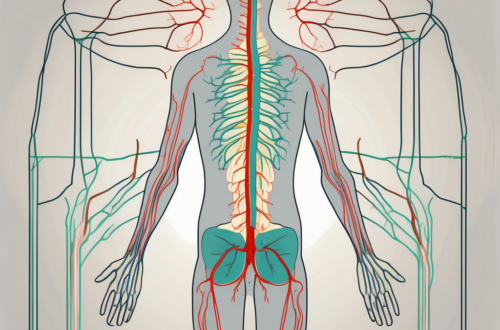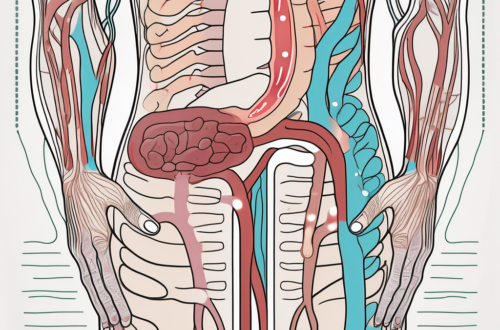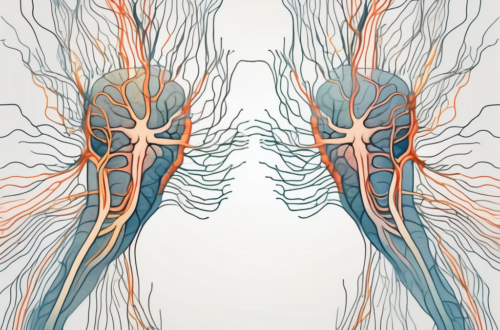In recent years, there has been a growing interest in the potential benefits of parasympathetic nerve fiber stimulation. This groundbreaking technique has shown promise in various fields, including neuroscience, stress management, and mental health. By understanding the intricacies of parasympathetic nerve fiber stimulation, we can gain valuable insights into its role in the body, the underlying science, its effects on body functions, its therapeutic applications, and the future directions of research in this field.
Understanding Parasympathetic Nerve Fiber Stimulation
The parasympathetic nervous system plays a crucial role in maintaining homeostasis in the body. It is responsible for conserving energy, promoting digestion, and regulating various bodily functions. Parasympathetic nerve fiber stimulation refers to the process of activating these nerves to induce specific physiological and psychological responses.
When we talk about the parasympathetic nervous system, we are referring to a branch of the autonomic nervous system. This system controls the body’s involuntary functions, allowing us to carry out essential tasks without conscious effort. The parasympathetic nerves work in opposition to the sympathetic nerves, which are responsible for the fight-or-flight response. While the sympathetic system prepares our body for action, the parasympathetic system helps to counterbalance the stressful effects of sympathetic activation by promoting relaxation and restoration.
The parasympathetic nerves have wide-ranging effects on the body. For example, they slow down our heart rate, constrict our pupils, stimulate digestion, and promote an overall sense of relaxation. By understanding the role of these nerves, we can harness their potential benefits for our overall well-being.
The Role of Parasympathetic Nerves in the Body
Let’s dive deeper into the role of parasympathetic nerves in the body. These nerves are responsible for regulating various bodily functions, ensuring that everything runs smoothly. One of their primary functions is to slow down our heart rate. When we are in a relaxed state, the parasympathetic system kicks in, reducing the heart’s activity and allowing it to beat at a more leisurely pace.
Another important role of the parasympathetic nerves is to constrict our pupils. This action helps to protect our eyes from excessive light and allows us to focus on nearby objects. When we are in a bright environment, the parasympathetic system works to narrow our pupils, reducing the amount of light that enters our eyes.
Furthermore, the parasympathetic system plays a significant role in stimulating digestion. When we eat a meal, the parasympathetic nerves are activated, signaling the release of digestive enzymes and promoting the absorption of nutrients. This process ensures that our bodies can efficiently break down food and extract the necessary energy and nutrients.
In addition to these functions, the parasympathetic nerves also promote relaxation throughout the body. They help to calm our mind, reduce stress levels, and create an overall sense of well-being. By activating these nerves, we can tap into the body’s natural ability to relax and rejuvenate.
The Science Behind Nerve Fiber Stimulation
Now, let’s explore the science behind parasympathetic nerve fiber stimulation. This process operates on the principles of neuroplasticity and neural adaptation. Neuroplasticity refers to the brain’s remarkable ability to change and reorganize itself in response to external stimuli. When we activate the parasympathetic nerves, we are essentially targeting specific neural circuits and promoting their adaptation.
Through nerve fiber stimulation, we can create lasting changes in the brain’s structure and function. This process involves strengthening the connections between neurons and enhancing the communication within neural networks. By doing so, we can optimize the functioning of the parasympathetic system, leading to long-lasting effects on our overall well-being.
Furthermore, parasympathetic nerve fiber stimulation triggers the release of neurotransmitters such as acetylcholine and dopamine. These neurotransmitters play crucial roles in modulating various bodily functions and promoting a sense of well-being. Acetylcholine, for example, is involved in muscle contraction, memory formation, and attention. Dopamine, on the other hand, is associated with pleasure, motivation, and reward.
By understanding the science behind nerve fiber stimulation, we can appreciate the intricate mechanisms at play and the potential benefits it holds for our physical and mental health.
The Process of Parasympathetic Nerve Fiber Release
The release of parasympathetic nerve fibers involves complex biochemical mechanisms and impacts numerous body functions. By understanding this process, we can gain insights into its therapeutic potential and better appreciate its effects.
The Biochemical Mechanisms Involved
Parasympathetic nerve fiber release relies on the activation of specific neural pathways and the modulation of neurotransmitter release. Through various techniques such as deep breathing exercises, meditation, and targeted electrical stimulation, we can induce the release and activation of parasympathetic nerves, promoting their therapeutic benefits.
Research has shown that the release of parasympathetic nerve fibers can trigger the release of endogenous opioids, which are natural pain-relieving compounds produced within the body. This mechanism can provide pain relief and promote relaxation in individuals suffering from chronic pain or acute stress.
Furthermore, the activation of parasympathetic nerves leads to the release of acetylcholine, a neurotransmitter responsible for transmitting signals between nerve cells. Acetylcholine acts on various target tissues, including smooth muscles, cardiac muscle, and glands, to elicit specific physiological responses. For example, in the digestive system, acetylcholine stimulates the secretion of digestive enzymes and increases gastrointestinal motility, aiding in the breakdown and absorption of nutrients.
In addition to acetylcholine, the release of parasympathetic nerve fibers also triggers the release of nitric oxide, a potent vasodilator. Nitric oxide relaxes the smooth muscles lining blood vessels, leading to vasodilation and a subsequent decrease in blood pressure. This vasodilatory effect helps improve blood flow to various organs and tissues, promoting their optimal function and overall health.
The Impact on Body Functions
Parasympathetic nerve fiber stimulation has a profound impact on various body functions. It can lower heart rate and blood pressure, improve digestion and gastrointestinal motility, and enhance the body’s ability to heal and recover from illness or injury.
When parasympathetic nerves are activated, the heart rate decreases due to the release of acetylcholine. This decrease in heart rate, known as bradycardia, allows the heart to work more efficiently and reduces the workload on the cardiovascular system. As a result, blood pressure also decreases, reducing the risk of cardiovascular diseases such as hypertension.
Furthermore, the activation of parasympathetic nerves promotes optimal digestion and gastrointestinal motility. Acetylcholine released by these nerves stimulates the secretion of digestive enzymes, such as amylase, lipase, and protease, aiding in the breakdown of carbohydrates, fats, and proteins, respectively. This enhanced digestive function ensures efficient nutrient absorption and prevents gastrointestinal discomfort and malabsorption issues.
In addition to its effects on the cardiovascular and digestive systems, parasympathetic nerve fiber release plays a crucial role in the body’s healing and recovery processes. By activating these nerves, the body enters a state of deep relaxation, allowing it to conserve energy and redirect resources towards tissue repair and regeneration. This accelerated healing response is particularly beneficial for individuals recovering from surgery, injuries, or chronic illnesses.
Moreover, parasympathetic nerve fiber release promotes deep states of relaxation and meditation. When these nerves are activated, the body enters a state of calmness and tranquility, reducing stress levels and promoting a sense of well-being. This relaxation response has been associated with numerous health benefits, including stress reduction, improved sleep quality, and enhanced cognitive function.
In conclusion, the process of parasympathetic nerve fiber release involves complex biochemical mechanisms and has a profound impact on various body functions. Understanding these mechanisms and their effects allows us to harness the therapeutic potential of parasympathetic nerve stimulation for improved health and well-being.
The Effects of Parasympathetic Nerve Fiber Stimulation
When parasympathetic nerves are stimulated, a cascade of physiological and psychological effects occurs. Understanding these effects is essential for harnessing the therapeutic potential of parasympathetic nerve fiber stimulation.
Parasympathetic nerve fiber stimulation promotes a range of physiological responses. It can lead to decreased heart rate and blood pressure, increased gastrointestinal activity, improved immune function, and enhanced overall well-being.
One of the significant physiological effects of parasympathetic nerve fiber stimulation is its ability to decrease heart rate and blood pressure. This response is particularly beneficial for individuals with hypertension or cardiovascular conditions. By reducing the workload on the heart, parasympathetic nerve fiber stimulation helps to maintain a healthy cardiovascular system.
In addition to its cardiovascular benefits, parasympathetic nerve fiber stimulation also enhances gastrointestinal activity. This stimulation increases the secretion of digestive enzymes and promotes smooth muscle contractions, facilitating efficient digestion and nutrient absorption. Individuals with digestive disorders, such as irritable bowel syndrome, may find relief through parasympathetic nerve fiber stimulation.
Furthermore, parasympathetic nerve fiber stimulation has been found to improve immune function. The activation of these nerves triggers the release of immune-modulating substances, such as cytokines, which help regulate the immune response. By enhancing immune function, parasympathetic nerve fiber stimulation may contribute to a reduced risk of infections and improved overall health.
Moreover, it has been observed that parasympathetic nerve fiber stimulation can reduce the production of stress hormones, such as cortisol, and increase the release of “feel-good” neurotransmitters, such as serotonin and endorphins. These neurochemical changes contribute to a sense of calmness and relaxation.
In addition to the physiological effects, parasympathetic nerve fiber stimulation also has noteworthy psychological benefits. It can promote a sense of tranquility, alleviate symptoms of anxiety and depression, and improve cognitive function, including focus, memory, and creative thinking.
Research has shown that parasympathetic nerve fiber stimulation can help individuals experience a state of tranquility. By activating these nerves, individuals may feel a deep sense of relaxation and peace, allowing them to better cope with stress and anxiety.
Furthermore, parasympathetic nerve fiber stimulation has been found to alleviate symptoms of anxiety and depression. The release of neurotransmitters, such as serotonin and endorphins, can help regulate mood and improve overall mental well-being. This stimulation may be particularly beneficial for individuals with mood disorders or those experiencing high levels of stress.
In addition to its calming and mood-enhancing effects, parasympathetic nerve fiber stimulation has been shown to improve cognitive function. By increasing blood flow to the brain and enhancing neural connectivity, this stimulation can enhance focus, memory, and creative thinking. Individuals seeking to optimize their cognitive abilities may find parasympathetic nerve fiber stimulation to be a valuable tool.
It is important to note that while parasympathetic nerve fiber stimulation can be a valuable tool for mental well-being, it is not a substitute for professional medical treatment. Individuals experiencing severe or chronic mental health issues should consult with a healthcare professional to explore their treatment options fully.
Therapeutic Applications of Parasympathetic Nerve Fiber Stimulation
The potential therapeutic applications of parasympathetic nerve fiber stimulation are vast. From neurological disorders to stress management and mental health, this innovative technique offers a wide range of possibilities for improving well-being.
Parasympathetic nerve fiber stimulation has shown promising potential in the treatment of various neurological disorders. Emerging research suggests that it may have applications in the management of migraines, epilepsy, and Parkinson’s disease. By modulating the activity of specific neural circuits associated with these conditions, targeted nerve fiber release may offer alternative or complementary therapies that can improve patients’ quality of life.
For individuals living with migraines, parasympathetic nerve fiber stimulation techniques can help alleviate symptoms and reduce the frequency of attacks. By activating the parasympathetic nervous system, these techniques promote relaxation and reduce the hyperactivity of neurons that contribute to migraine episodes.
Similarly, individuals with epilepsy may benefit from parasympathetic nerve fiber stimulation as an adjunct therapy. By modulating the activity of the vagus nerve, which plays a crucial role in seizure control, this technique can help reduce the frequency and severity of seizures, enhancing the overall management of the condition.
In the case of Parkinson’s disease, parasympathetic nerve fiber stimulation holds promise for improving motor symptoms and enhancing the effectiveness of existing treatments. By targeting specific neural pathways involved in movement control, this technique may help alleviate rigidity, tremors, and bradykinesia, ultimately improving patients’ mobility and quality of life.
However, it is essential to approach these potential benefits with caution. Consulting a healthcare professional or specialist is crucial to evaluate individual circumstances and determine the appropriateness of parasympathetic nerve fiber stimulation as part of a comprehensive treatment plan.
In addition to its potential applications in neurological disorders, parasympathetic nerve fiber stimulation also offers implications for stress management and mental health. In today’s fast-paced and demanding world, chronic stress has become a prevalent concern, with significant implications for mental well-being.
Parasympathetic nerve fiber stimulation techniques, such as deep breathing exercises, meditation, and yoga, can help counterbalance the effects of chronic stress and promote relaxation. By activating the parasympathetic nervous system, these techniques induce a state of calmness and tranquility, reducing the physiological and psychological symptoms associated with stress.
Moreover, parasympathetic nerve fiber stimulation has been shown to have positive effects on mental health. It can help alleviate symptoms of anxiety and depression by promoting a sense of well-being and improving emotional regulation. By activating the parasympathetic nervous system, these techniques enhance the release of neurotransmitters such as serotonin and dopamine, which play a crucial role in mood regulation.
While parasympathetic nerve fiber stimulation can be an effective tool for stress management and mental well-being, it is important to note that it may not be suitable for everyone. Individuals with certain medical conditions or underlying health issues should consult with a healthcare professional to explore the most appropriate strategies for stress management and mental well-being.
Future Directions in Parasympathetic Nerve Fiber Stimulation Research
The field of parasympathetic nerve fiber stimulation is still in its early stages, with much to explore and discover. Ongoing research is focused on uncovering emerging techniques, technologies, and unanswered questions that can further our understanding and harness the full therapeutic potential of parasympathetic nerve fiber stimulation.
One area of research that shows promise is the use of advanced neuroimaging techniques to better understand the effects of parasympathetic nerve fiber stimulation on the brain. Functional magnetic resonance imaging (fMRI) and positron emission tomography (PET) scans can provide valuable insights into the neural pathways and mechanisms involved in parasympathetic nerve fiber stimulation. By mapping out these pathways, researchers hope to develop more targeted and effective stimulation protocols.
In addition to neuroimaging, biofeedback mechanisms are also being explored as a way to enhance parasympathetic nerve fiber stimulation. Biofeedback allows individuals to monitor their physiological responses, such as heart rate and blood pressure, in real-time. By providing this feedback, individuals can learn to control and regulate their parasympathetic nervous system activity, potentially leading to improved health outcomes.
Non-invasive electrical stimulation methods are another area of interest in parasympathetic nerve fiber stimulation research. Transcutaneous vagus nerve stimulation (tVNS) is a non-invasive technique that involves applying electrical stimulation to the auricular branch of the vagus nerve, which is located in the ear. This method has shown promise in various clinical applications, including the treatment of depression, anxiety, and chronic pain.
Unanswered Questions and Potential Discoveries
While significant progress has been made, numerous questions remain unanswered in the field of parasympathetic nerve fiber stimulation. Researchers are actively investigating the optimal stimulation parameters, the long-term effects of repeated stimulation, and the individual variability in response to stimulation.
One area of interest is determining the ideal frequency and duration of stimulation sessions. Current research suggests that different frequencies may have varying effects on the parasympathetic nervous system, but more studies are needed to establish the optimal parameters for different therapeutic applications.
Another unanswered question is the long-term effects of repeated stimulation. While short-term studies have shown promising results, it is still unclear whether long-term stimulation can lead to sustained improvements in health outcomes. Longitudinal studies that follow participants over an extended period are needed to address this question.
Furthermore, researchers are exploring the individual variability in response to parasympathetic nerve fiber stimulation. Some individuals may experience significant benefits from stimulation, while others may not respond as strongly. Understanding the factors that contribute to this variability, such as genetics and baseline physiological state, could help personalize and optimize stimulation protocols.
In conclusion, the field of parasympathetic nerve fiber stimulation is rapidly evolving, with ongoing research focused on uncovering new techniques, technologies, and answers to unanswered questions. Advanced neuroimaging techniques, biofeedback mechanisms, and non-invasive electrical stimulation methods are just a few examples of the cutting-edge approaches being investigated. By addressing these unanswered questions and exploring emerging avenues of research, we can further harness the therapeutic potential of parasympathetic nerve fiber stimulation and improve overall well-being and mental health in the years to come.





